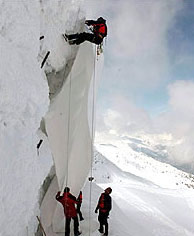 |
 |
 |
 Editorials | Environmental | May 2005 Editorials | Environmental | May 2005  
Swiss Put Glacier Under Wraps to Slow Ice Melt
 Vincent Fribault - Reuters Vincent Fribault - Reuters


| | A Swiss ski resort is playing Christo and covering about 2,500 square meters of a glacier with a 4mm-thick thick sheet of white foil in order to slow its rate of melting. They want to preserve the bank of ice because it connects skiers to a lift. (Photo: BBC) |
Gemsstock, Switzerland - Alarmed by the retreat of its Alpine glacier, a Swiss ski resort on Tuesday wrapped part of the shrinking ice-cap in a giant blanket in a bid to reduce the summer melt.

If successful, officials at the Gemsstock resort above Andermatt in central Switzerland expect the example to be followed elsewhere in the Alps, where scientists say glaciers are under threat from global warming.

"We think it will become common practice to cover parts of the glaciers," Urs Elmiger, a board member of Andermatt Gotthard Sportbahnen, the cable car operator behind the project, told Reuters.

A thin protective layer of artificial textiles, including polyester, was laid over an area of 3-4,000 square metres (yards). The fleece-like material, hard to distinguish with the naked eye from snow, will reflect the rays of the sun.

The 100,000 Swiss franc ($83,000) blanket will protect one of the main glacier access ramps, which has to be rebuilt each autumn at the start of the ski season to cover a yawning 20-metre gap opened up by the ice melt.

"It needs a lot of work, energy and money to rebuild. And one day, if the melt increases, the cost of rebuilding the ramp will be very, very high," said Elmiger.

But scientists stressed that while such defensive actions could prove valuable in selected spots, such as access areas or cable car installations, they were not a solution to the overall problem of the vanishing ice fields worldwide.

"It may be useful very locally, but it would be totally unfeasible - economically and ecologically - to cover completely even a small glacier," said geography professor Wilfried Haeberli of the University of Zurich.

The Alpine glaciers - also in Austria, France and Italy - are losing one percent of their mass every year and, even supposing no acceleration in that rate, will have all but disappeared by the end of the century.

More hot, dry summers like that of 2003 in Europe, when the loss speeded to five percent, could cut the life expectancy to no more than 50 years, Haeberli added.

"We estimate that by the end of the 21st century, with a medium-type climate scenario, about five percent of what existed in the 1970s will have survived," he told Reuters.

For Martin Hiller, spokesman on climate change for environmentalist group WWF International, who was on hand to witness the Alpine experiment, the move was positive but offered no real answer to ice loss.

"The solution is to switch to clean energy, we need to cut down on harmful pollutants, such as CO2 (carbon dioxide)," he said. | 
 | |
 |



